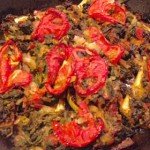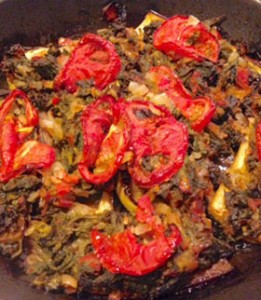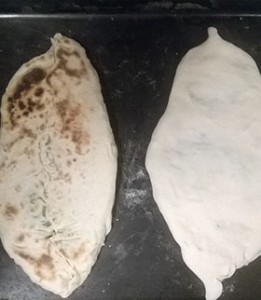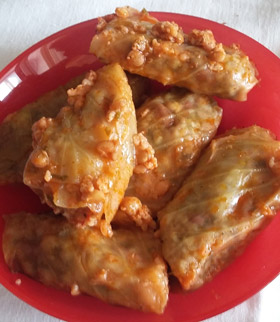Եղինջով իմամ բայալդի | Imam Baildi with Nettle
|
Եղինջով իմամ բայալդի
|
| Բաղադրիչներ | Ingredients | |
|
2 հատ մեծ չափի սմբուկ (երկար և ոչ հաստ) |
2 large eggplants (long and skinny kind) |
| Պատրաստման եղանակը | Directions | |
|
Նախ և առաջ կտրել սմբուկի ծայրերը, շերտագծերով կլպել (մեկընդմեջ թողնելով մեկ սպիտակ շերտագիծ, մեկ մանուշակագույն): Երկայնակի մեջտեղից կտրել, այնուհետև այդ մասերը նույնպես երկու կես անել: Միջուկի մի մասը միջից հանել՝ տալով դրան նավակի տեսք (մի կողմ դնել միջուկը): Սմբուկի կտրտած մասերը թաթախել աղաջրով թասի մեջ (աղաջուրը փափկեցնում է սմբուկը և նվազեցնում դրա դառնությունը) և մի կողմն դնել՝ պատրաստելով մյուս բաղադրիչները: Ջեռոցը նախօրոք տաքացնել մինչև 375ºF (190,556ºC): Կտրտել սոխը, լոլիկներից մեկը և ճզմել սխտորը: Կաթսայի մեջ տաքացնել ½ ճ/գ կոկոսի յուղը և դրա վրա լցնել մյուս բաղադրիչները: Երկու րոպե տապակել միջին կրակի վրա: Եղինջը մեծ-մեծ կտրտել և լցնել կաթսայում եղած զանգվածի վրա շաքարավազի, աղի և սմբուկի միջուկի հետ միասին: Լավ խառնել, կաթսայի բերանը ծածկել և թողնել, որ եփի 10 րոպե միջին կրակի վրա: Մինչև եղինջի խառնուրդի եփվելը, ջրից հանել սմբուկի կտորները, ջուրը միջից լավ քամել և դնել ջեռոցի համար նախատեսված թավայի մեջ: Սմբուկի կտորների վրա ցանել կիտրոնի հյութ և ձիթապտղի ձեթ. թավայի մեջ լցնել ¼ բաժակ ջուր: Թավան ծածկել փայլաթիթեղով և դնել ջեռոցի մեջ՝ թողնելով 20 րոպե (այնպես, որ սմբուկը փափկի, բայց ոչ ամբողջովին եփվի): Այնուհետև սմբուկի կտորները լցոնել եղինջի խառնուրդով, փայլաթիթեղով նորից ծածկել և դնել ջեռոցի մեջ՝ թողնելով 10-15 րոպե: Հանել փայլափիթեղը և սմբուկի ամեն կտորի վրա դնել լոլիկի մի բարակ կտրտած շերտ, վրան ցանել մի փոքր աղ և շաքարավազ: Թավան առանց ծածկելու նորից դնել ջեռոցի մեջ, մինչև դրանում եղած ջուրը գոլորշիանա և սմբուկը ամբողջությամբ եփվի (մոտավորապես 10 րոպե): First, cut off the ends of the eggplant, peel them in strips (one white strip, one purple). Cut them in half lengthwise and then in half again. Scoop out some of the insides to make a boat (set aside the insides). Soak the eggplant pieces in a bowl of salted water (softens them and reduces bitterness) and set them aside while you prepare the other ingredients. Preheat the oven to 375*F. Chop the onions and 1 tomato and press the garlic. Heat a 1/2 TB of coconut oil in a pot and add the ingredients to the pot. Saute for two minutes on medium heat. Chop the nettle roughly and add it to the pot along with the sugar, salt and eggplant insides you set aside. Stir well, cover and cook on medium heat for 10 minutes. While the nettle mixture is cooking, remove the eggplant pieces from the water, squeeze out any excess water and place them on an oven safe pan. Drizzle them with lemon juice and olive oil. Add 1/4 cup water to bottom of the pan. Cover the pan with foil and place it in the oven for 20 minutes (the eggplant should be soft but not cooked thoroughly). Fill each eggplant with the nettle mixture, cover again and put it back in the oven for 10-15 minutes. Remove the foil and add thin slices of tomato to each eggplant boat, sprinkle with a touch of salt and sugar. Place back in the oven uncovered until the water has evaporated and the eggplant is cooked thoroughly (about 10 more minutes). |
|
Ժենգյալով հաց | Jingalov Hats
|
Ժենգյալով հաց
|
| Պատմություն | Story | |
|
Ժենգյալով հացը բաղադրատոմս չունեցող ուտեստ է, որը պատրաստվում է սեզոնին առկա կանաչիներով, ուստի այն առավել տարածված է գարնանը և աշնանը (մյուս եղանակներին կանաչիները դառնանում են): Այն առաջին անգամ սկսել են պատրաստել դժվարին տարիների ընթացքում՝ ելնելով այն մտածելակերպից, որ «ղարաբաղցին սոված չի մնում», դրանով արտահայտելով ժողովրդի աննկուն կամքը և վճռականությունը: Այդ իսկ պատճառով այն հաճախ թարգմանվում է որպես «անտառային հաց», քանի որ գոյատևման համար մարդիկ ուտում էին ձեռքի տակ ընկածը: It is a recipe-less dish, used with the greens in season, so it is most popular during the spring and fall time (other seasons the greens are too bitter). It was first created during the difficult times with the mentality that “Karabaghstin sovadz chi mnoum” (the people of Karabakh do not remain hungry), noting the strong will and determination of the people. This is why it is often translated as “forest bread,” as the idea was for people to eat whatever they could find in order to survive. |
|
| Բաղադրիչներ | Ingredients | |
|
ալյուր |
flour |
| Պատրաստման եղանակը | Directions | |
|
Հունցել ալյուրն ու ջուրը, այնուհետև բարակ գրտնակել խմորը: Կտրտած կանաչիների վրա լցնել ձեթ և աղ (աղը պետք է լինի չափավոր, քանի որ «կանարիները աղ չեն սիրում»), խառնել զանգվածը և դնել խմորի միջին մասում: Խմորի ծայրերը միացնել իրար՝ դրան տալով նավակի տեսք: Այնուհետև դնել սաջի (տափակ երկաթե թավա) թավայի մեջ. այն պետք է լավ եփել, բայց այնպես անել, որ խրթխրթան մնա: Knead the dough and water and flatten it out. Mix the chopped up herbs with some oil and salt (not too much salt, as “greens don’t like salt”) and add it in the middle. Close up the dough keeping the shape like a boat, and put directly on a saj pan. the goal is to keep it cooked but crunchy. |
|
Պասուց տոլմա | Pasuts (Lenten) Dolma
|
Պասուց Դօլմա
|
| Պատմություն | Story | |
|
Այս ուտեստը պատրաստում էին հատկապես Մեծ Պահքի շրջանում, որի ընթացքում շատ հայեր դադարում էին ուտել կենդանական ծագում ունեցող մթերք: Թեև այսօր այն պատրաստում են ամբողջ տարվա ընթացքում, Հայաստանում դեռևս կան ռեստորաններ, որոնք այն մատուցում են միայն «սեզոնին»՝ համաձայն հին մտածելակերպի: This is a dish made especially for the time of Lent, where many Armenians abstain from eating any foods from animals. While it now popular year-round, there are some restaurants in Armenia that only serve it “in season” due to old-fashioned ideas! |
|
| Բաղադրիչներ | Ingredients | |
|
700 գ ձեթ |
700g oil |
| Պատրաստման եղանակը | Directions | |
|
700 գ ձեթի մեջ լցնել նախապես մանր կտրատած 1 կգ սոխը և դնել գազօջախին: Երբ սոխառածը դառնում է ոսկեգույն, ավելացնել 1 ճաշի գդալ կարմիր պղպեղ, չորացրած ծիթրոն ու (շատ քիչ) ռեհան` ըստ ճաշակի և թողնել, որ մի 5 րոպե եփի սոխառածի մեջ: Այնուհետև ավելացնել 4 ճաշի գդալ տոմատի մածուկ, և սպասել ևս մի քանի րոպե, որպեսզի եփի: Հետո սոխառածին ավելացնել նախօրոք խաշած 0,5 կգ կարմիր հատիկ լոբի, 0,5 կգ ոլոռ, 0,5 կգ սիսեռ, 0,5 կգ ոսպ (առանց խաշելու), 300-400 գ հաճար (կամ աղացած ձավար) և 250 գ բրինձ: Այս ամենը լավ խառնել իրար, հետո ավելացնել 1 ճաշի գդալ աղ, կտրատած համեմ ու մաղադանոս: Նորից լավ խառնել, փակել կաթսան կափարիչով և թողնել, որ մոտավորապես 30 րոպե եփի իր գոլորշիով: Մեկ այլ կաթսայով 1,5 լ ջուրը դնել եռալու, ավելացնել 1 ճաշի գդալ աղ: Այդ ընթացքում վերցնել մի մեծ գլուխ կաղամբ, թերթերն անջատել կոթից: Երբ ջուրը սկսում է եռալ, կաղամբի թերթիկները լցնել եռացող ջրի մեջ: Հենց թերթիկները սկսում են թուլանալ, հանել և դնել սառը ջրի մեջ, ապա` փլավքամիչի: Այնուհետև դանակով կտրել և հեռացնել կաղամբի կոպիտ մասերը, որպեսզի փաթաթելիս չխանգարեն: Երբ պասուց տոլմայի միջուկը պատրաստ է լինում, անցնել բուն գործողությանը: Կաղամբի թուփը բացել ափի վրա, եթե շատ մեծ է և դժվարանում եք, կարող եք փռել նաև խոհանոցային փայտի վրա, ավելացնել մեկ կամ երկու ճաշի գդալ միջուկ: Այնուհետև փաթաթել գեղեցիկ ու նրբորեն: Մեկ այլ կաթսայի տակ փռել կաղամբի թփեր: Փաթաթված պասուց տոլմաները հերթով շարքերով շարել: Փաթաթելն ավարտելուց հետո դնել եփելու, մոտ 30 րոպե: Ուտել սառը վիճակում: Heat 700g oil with 1kg chopped onions mixed together. Once the caramelized onion becomes gold, add 1 tablespoon of red pepper, dried rosemary and (a little) basil to taste. Cook it together for 5 minutes. Add 4 tablespoon of tomato paste, cooking it for a few more minutes. Then add 0,5kg red beans, 0,5kg green peas and 0,5kg chickpeas, cooked separately, 0,5kg lentils (not cooked), 300-400g spelt (or ground oat groats) and 250g rice. Stir the mixture, add 1 tablespoon of salt, chopped coriander and parsley. Again stir it well, cover and cook it for 30 minutes. Boil 1,5 litre water separately, add 1 tablespoon of salt. Remove the cabbage leaves off the core. As soon as the water boils, put the leaves into the water, boil until they become soft. Take them out and put into cold water and afterwards into a filter to drain. Cut off the rough parts of the leaves with a knife so as to easily make the rolls. When the filling is ready, proceed with the main task. Open up the cabbage leave on your palm but if it is too large, put it on a chopping board. Place 1 or 2 tablespoon of the filling on the leaf. Roll it up finely. Place cabbage leaves on the bottom of another saucepan. Put the rolled dolmas one by one in rows. Then cook it for about 30 minutes. Serve cold. |
|









